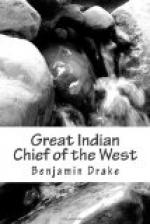The tribe thus subdued by the pacific and philanthropic principles of Penn, have been untruly described as a cowardly and broken down race. They were a branch of the great family of Indians, who, for so many years, carried on a fierce and bloody strife with the Alligewi on the Mississippi, and waged a determined hostility with the Mengwe. At one period they were the undisputed masters of the large tract of country, now known as the territory of the middle states. On the arrival of the English, their number in Pennsylvania was computed at thirty or forty thousand souls. Their history spoke only of conquest. They were a brave, proud and warlike race, who gloried in the preservation of a character for valor, descended from the remotest times. The confederacy of the Six Nations, by whom they were finally vanquished, was not formed until 1712, and their defeat, as evidenced by their peculiar subjugation occurred within a few months antecedent to the demise of the proprietary. The same people annihilated the colony of Des Vries, in 1632, formed a conspiracy to exterminate the Swedes, under Printz, in 1646; and were the authors of the subsequent murders which afflicted the settlements, before the accession of the English colonists.
“Such an example furnishes some insight into the elements of Indian character. Little doubt can exist, if the subject were fairly examined, that most of those sanguinary wars, of which history speaks with a shudder, would be found to have arisen less from the blood-thirsty Indian, than from the aggressions of the gold-thirsty and land-thirsty defamer.”
INDIAN DANCING CEREMONIES.
In a historical memoir of the Indians, published in the North American Review and attributed to the able pen of our present minister to France, there is a description of a war-dance, from which the following extract is made.
“An Indian War Dance is an important occurrence in the passing events of a village. The whole population is assembled, and a feast provided for all. The warriors are painted and prepared as for battle. A post is firmly planted in the ground, and the singers, the drummers and other musicians, are seated within the circle formed by the dancers and spectators. The music and the dancers begin. The warriors exert themselves, with great energy. Every muscle is in action: and there is the most perfect concord between the music and their movements. They brandish their weapons, and with such apparent fury, that fatal accidents seem unavoidable. Presently a warrior leaves the circle, and with his tomahawk or casse-tete, strikes the post. The music and dancing cease, and profound silence ensues. He then recounts, with a loud voice, his military achievements. He describes the battles he has fought—the prisoners he has captured—the scalps he has taken. He points to his wounds, and produces his trophies. He accompanies his narrative with the actual representation of his exploits;




